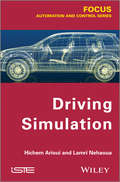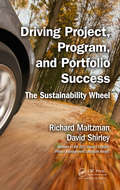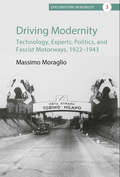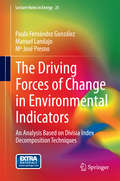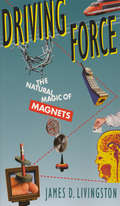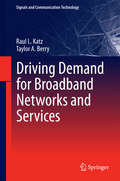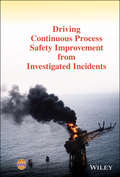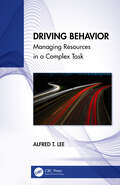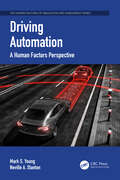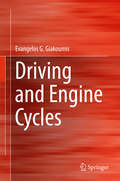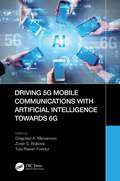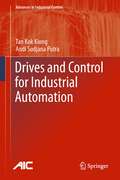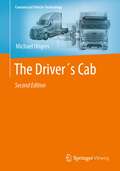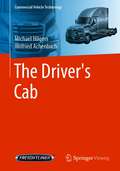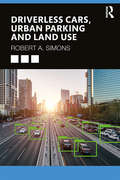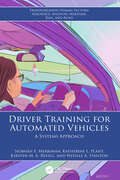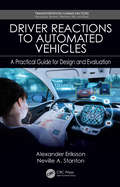- Table View
- List View
Driving Simulation
by Hichem Arioui Lamri NehaouaPassive and active safety systems (ABS, ESP, safety belts, airbags, etc.) represent a major advance in terms of safety in motoring. They are increasingly developed and installed in cars and are beginning to appear in twowheelers. It is clear that these systems have provenefficient, although there is no information about their actual operation by current users. The authors of this book present a state of the art on safety systems and assistance to driving and their two-wheeled counterparts. The main components constituting a driving simulator are described, followed by a classification of robotic architectures. Then, a literature review on driving simulators and two-wheeled vehicles is presented. The aim of the book is to point out the differences of perspectives between motor vehicles and motorcycles to identify relevant indicators to help in choosing the mechanical architecture of the motorcycle simulator and appropriate controls. Contents 1. Driving Simulation.2. Architecture of Driving Simulators.3. Dynamics of Two-Wheeled Vehicles.4. Two-Wheeled Riding Simulator: From Design to Control.
Driving Project, Program, and Portfolio Success: The Sustainability Wheel
by Richard Maltzman David ShirleyBusiness sustainability is the management of environmental, social, and financial demands to ensure responsible, ethical, and ongoing success. Businesses appear to have not only bought into integrating sustainability into their business plans, but have started profiting from it. This book helps project, program, and portfolio managers to integrate
Driving Modernity: Technology, Experts, Politics, and Fascist Motorways, 1922-1943 (Explorations in Mobility #3)
by Massimo MoraglioOn March 26th, 1923, in a formal ceremony, construction of the Milan–Alpine Lakes autostrada officially began, the preliminary step toward what would become the first European motorway. That Benito Mussolini himself participated in the festivities indicates just how important the project was to Italian Fascism. Driving Modernity recounts the twisting fortunes of the autostrada, which—alongside railways, aviation, and other forms of mobility—Italian authorities hoped would spread an ideology of technological nationalism. It explains how Italy ultimately failed to realize its mammoth infrastructural vision, addressing the political and social conditions that made a coherent plan of development impossible.
Driving Modernity: Technology, Experts, Politics, and Fascist Motorways, 1922-1943 (Explorations in Mobility #3)
by Massimo MoraglioOn March 26th, 1923, in a formal ceremony, construction of the Milan–Alpine Lakes autostrada officially began, the preliminary step toward what would become the first European motorway. That Benito Mussolini himself participated in the festivities indicates just how important the project was to Italian Fascism. Driving Modernity recounts the twisting fortunes of the autostrada, which—alongside railways, aviation, and other forms of mobility—Italian authorities hoped would spread an ideology of technological nationalism. It explains how Italy ultimately failed to realize its mammoth infrastructural vision, addressing the political and social conditions that made a coherent plan of development impossible.
The Driving Forces of Change in Environmental Indicators: An Analysis Based on Divisia Index Decomposition Techniques (Lecture Notes in Energy #25)
by Paula Fernández González Manuel Landajo Mª José PresnoThis book addresses several index decomposition analysis methods to assess progress made by EU countries in the last decade in relation to energy and climate change concerns. Several applications of these techniques are carried out in order to decompose changes in both energy and environmental aggregates. In addition to this, a new methodology based on classical spline approximations is introduced, which provides useful mathematical and statistical properties. Once a suitable set of determinant factors has been identified, these decomposition methods allow the researcher to quantify the respective contributions of these factors. A proper interpretation of findings enables the design of strategies and a number of energy and environmental policies to control the variables of interest. This book also analyses the impact of several factors that allow control of these variables; among them, assessment of the specific contribution of improved energy efficiency is particularly relevant. A number of divisia-index-based techniques for decomposing changes in a generic indicator are now available, and these range from classical techniques based on Laspeyres and Paasche weights to more refined approaches relying on logarithmic mean weighting schemes. This book is intended for undergraduates and graduates of energy economics and environmental sciences, environmental policy advisors, and industrial engineers.
Driving Force: The Natural Magic of Magnets
by James D. LivingstonDriving Force unfolds the long and colorful history of magnets: how they guided (or misguided) Columbus; mesmerized eighteenth-century Paris but failed to fool Benjamin Franklin; lifted AC power over its rival, DC, despite all the animals, one human among them, executed along the way; led Einstein to the theory of relativity; helped defeat Hitler’s U-boats; inspired writers from Plato to Dave Barry. In a way that will delight and instruct even the nonmathematical among us, James Livingston shows us how scientists today are creating magnets and superconductors that can levitate high-speed trains, produce images of our internal organs, steer high-energy particles in giant accelerators, and—last but not least—heat our morning coffee. From the “new” science of materials to everyday technology, Driving Force makes the workings of magnets a matter of practical wonder. The book will inform and entertain technical and nontechnical readers alike and will give them a clearer sense of the force behind so much of the working world.
Driving Demand for Broadband Networks and Services (Signals and Communication Technology)
by Raul L. Katz Taylor A. BerryThis book examines the reasons why various groups around the world choose not to adopt broadband services and evaluates strategies to stimulate the demand that will lead to increased broadband use. It introduces readers to the benefits of higher adoption rates while examining the progress that developed and emerging countries have made in stimulating broadband demand. By relying on concepts such as a supply and demand gap, broadband price elasticity, and demand promotion, this book explains differences between the fixed and mobile broadband demand gap, introducing the notions of substitution and complementarity between both platforms. Building on these concepts, ‘Driving Demand for Broadband Networks and Services’ offers a set of best practices and recommendations aimed at promoting broadband demand. The broadband demand gap is defined as individuals and households that could buy a broadband subscription because they live in areas served by telecommunications carriers but do not do so because of either economic, limited awareness, or lack of digital literacy reasons. This grouping represents a range from 30% of the population in the US, 40% in Germany, and over 80% in most emerging countries. Research indicates that broadband usage is critical for social development, economic performance, and overall welfare and so it behoves governments to encourage demand. This study is the first of its kind to address the demand side of broadband diffusion, incorporating an economic analysis while offering real world examples of policies and initiatives that have successfully spurred demand in developed and emerging markets alike. This book is intended for policy makers, managers of telecommunications and other technology companies, as well as academics and graduate students in the areas of public policy, economic development, and technology management. This book is an eye-opener for policy makers. Traditionally ICT policy has focused on the supply side. Katz and Berry develop great ideas to leapfrog Internet penetration from the demand side, where the value of the Internet is. - Diego Molano Vega, Minister of Information Technologies and Communications of Colombia This book is an instant classic. It brilliantly and convincingly lays out the case why dealing with inadequate internet penetration has moved from the creation of supply to one of encouraging demand. It provides an information-rich and well-written presentation of the factors holding back people from becoming users, and offers a hugely valuable survey of the various programs around the world to make the broadband internet truly useful to people everywhere. It is the kind of book writers in this field will use constantly. - Eli Noam, Professor of Finance and Economics, Columbia Business School This new study by Katz and Berry examines the rationale for national broadband plans and the evidence for their success in driving demand. It presents the latest data on broadband in a range of case study countries, and provides best practice advice for policy-makers and development practitioners. - Dr Tim Kelly, Lead ICT Policy Specialist, World Bank
Driving Continuous Process Safety Improvement From Investigated Incidents
by CCPS (Center for Chemical Process Safety)New perspectives on how to share the lessons learned from publicly investigated process safety incidents Driving Continuous Process Safety Improvement from Investigated Incidents offers a novel view on how to successfully communicate process safety incident lessons. This book comes from the Center for Chemical Process Safety (CCPS), providing learning models and sharing techniques. This important book: Offers guidelines for improving process safety performance by applying the lessons learned from publicly available incident investigations Presents the background for and recommends a continuous improvement learning model Provides scenario examples for using the model’s techniques and how to internalize the learnings Written for safety professionals and process safety consultants, Driving Continuous Process Safety Improvement from Investigated Incidents is a hands-on guide for adopting a model for successfully communicating the learnings from process safety incident investigations.
Driving Continuous Process Safety Improvement From Investigated Incidents
by CCPS (Center for Chemical Process Safety)New perspectives on how to share the lessons learned from publicly investigated process safety incidents Driving Continuous Process Safety Improvement from Investigated Incidents offers a novel view on how to successfully communicate process safety incident lessons. This book comes from the Center for Chemical Process Safety (CCPS), providing learning models and sharing techniques. This important book: Offers guidelines for improving process safety performance by applying the lessons learned from publicly available incident investigations Presents the background for and recommends a continuous improvement learning model Provides scenario examples for using the model’s techniques and how to internalize the learnings Written for safety professionals and process safety consultants, Driving Continuous Process Safety Improvement from Investigated Incidents is a hands-on guide for adopting a model for successfully communicating the learnings from process safety incident investigations.
Driving Behavior: Managing Resources in a Complex Task
by Alfred T. LeeIn the U.S., drivers over the age of 65 now account for nearly 20% of licensed drivers. This number will increase by 25% to nearly 70 million by the year 2030. Some of these older drivers may not be capable of operating their vehicles safely in all conditions. The book investigates the key aspects of driving tasks and their relation to the sensory, perceptual, motor, and cognitive processes. Effects on driving performance, including aging, are described with a view toward improving future vehicle and road design as well as driver training and evaluation. This title: Presents a comprehensive, quantitative analysis of human physical and mental processes to driving behavior. Showcases recent review and analysis of driver, vehicle, and road environment design factors. Discusses the fundamentals of driving behavior in vehicle control and guidance, collision avoidance, and hazard perception. Examines the effects of design issues on vehicles and road environments. Highlights specific quantifiable attributes of physical and mental functions related to driving approaches. Written for professionals in diverse fields including ergonomics, health and safety, human factors, transportation engineering, and automotive engineering, this book is the essential guide to driving practices and habits. Its appeal will extend to those involved in vehicle design, roadway environments, driver training, and regulatory agencies.
Driving Behavior: Managing Resources in a Complex Task
by Alfred T. LeeIn the U.S., drivers over the age of 65 now account for nearly 20% of licensed drivers. This number will increase by 25% to nearly 70 million by the year 2030. Some of these older drivers may not be capable of operating their vehicles safely in all conditions. The book investigates the key aspects of driving tasks and their relation to the sensory, perceptual, motor, and cognitive processes. Effects on driving performance, including aging, are described with a view toward improving future vehicle and road design as well as driver training and evaluation. This title: Presents a comprehensive, quantitative analysis of human physical and mental processes to driving behavior. Showcases recent review and analysis of driver, vehicle, and road environment design factors. Discusses the fundamentals of driving behavior in vehicle control and guidance, collision avoidance, and hazard perception. Examines the effects of design issues on vehicles and road environments. Highlights specific quantifiable attributes of physical and mental functions related to driving approaches. Written for professionals in diverse fields including ergonomics, health and safety, human factors, transportation engineering, and automotive engineering, this book is the essential guide to driving practices and habits. Its appeal will extend to those involved in vehicle design, roadway environments, driver training, and regulatory agencies.
Driving Automation: A Human Factors Perspective (The Human Factors, Simulation and Performance Assessment Series)
by Mark S. Young Neville A. StantonThe technology behind self-driving cars is being heavily promulgated as the solution to a variety of transport problems including safety, congestion, and impact on the environment. This text examines the key role that human factors plays in driving forward future vehicle automation in a way that realizes the benefits while avoiding the pitfalls. Driving Automation: A Human Factors Perspective addresses a range of issues related to vehicle automation beyond the 'can we' to 'how should we'. It covers important topics including mental workload and malleable attentional resources theory, effects of automation on driver performance, in-vehicle interface design, driver monitoring, eco-driving, responses to automation failure, and human-centred automation. The text will be useful for graduate students and professionals in diverse areas such as ergonomics/human factors, automobile engineering, industrial engineering, mechanical engineering, and health and safety.
Driving Automation: A Human Factors Perspective (The Human Factors, Simulation and Performance Assessment Series)
by Mark S. Young Neville A. StantonThe technology behind self-driving cars is being heavily promulgated as the solution to a variety of transport problems including safety, congestion, and impact on the environment. This text examines the key role that human factors plays in driving forward future vehicle automation in a way that realizes the benefits while avoiding the pitfalls. Driving Automation: A Human Factors Perspective addresses a range of issues related to vehicle automation beyond the 'can we' to 'how should we'. It covers important topics including mental workload and malleable attentional resources theory, effects of automation on driver performance, in-vehicle interface design, driver monitoring, eco-driving, responses to automation failure, and human-centred automation. The text will be useful for graduate students and professionals in diverse areas such as ergonomics/human factors, automobile engineering, industrial engineering, mechanical engineering, and health and safety.
Driving and Engine Cycles
by Evangelos G. GiakoumisThis book presents in detail the most important driving and engine cycles used for the certification and testing of new vehicles and engines around the world. It covers chassis and engine-dynamometer cycles for passenger cars, light-duty vans, heavy-duty engines, non-road engines and motorcycles, offering detailed historical information and critical review. The book also provides detailed examples from SI and diesel engines and vehicles operating during various cycles, with a focus on how the engine behaves during transients and how this is reflected in emitted pollutants, CO2 and after-treatment systems operation. It describes the measurement methods for the testing of new vehicles and essential information on the procedure for creating a driving cycle. Lastly, it presents detailed technical specifications on the most important chassis-dynamometer cycles around the world, together with a direct comparison of those cycles.
Driving 5G Mobile Communications with Artificial Intelligence towards 6G
by Dragorad A. Milovanovic Zoran S. Bojkovic Tulsi Pawan FowdurDriving 5G Mobile Communications with Artificial Intelligence towards 6G presents current work and directions of continuously innovation and development in multimedia communications with a focus on services and users. The fifth generation of mobile wireless networks achieved the first deployment by 2020, completed the first phase of evolution in 2022, and started transition phase of 5G-Advanced toward the sixth generation. Perhaps one of the most important innovations brought by 5G is the platform-approach to connectivity, i.e., a single standard that can adapt to the heterogeneous connectivity requirements of vastly different use cases. 5G networks contain a list of different requirements, standardized technical specifications and a range of implementation options with spectral efficiency, latency, and reliability as primary performance metrics. Towards 6G, machine learning (ML) and artificial intelligence (AI) methods have recently proposed new approaches to modeling, designing, optimizing and implementing systems. They are now matured technologies that improve many research fields significantly. The area of wireless multimedia communications has developed immensely, generating a large number of concepts, ideas, technical specifications, mobile standards, patents, and articles. Identifying the basic ideas and their complex interconnections becomes increasingly important. The book is divided into three major parts, with each part containing four or five chapters: Advanced 5G communication Machine learning-based communication and network automation Artificial Intelligence towards 6G The first part discusses three main scenarios and standard specification of 5G use cases (eMBB, URLLC, mMTC), vehicular systems beyond 5G, and efficient edge architecture on NFV infrastructure. In the second part, different AI/ML-based methodologies and open research challenges are presented in introducing 5G-AIoT artificial intelligence of things, scheduling in 5G/6G communication systems, application of DL techniques to modulation, detection, and channel coding as well as 5G Open Source tools for experimentations and testing. The third part paved the way to deployment scenarios for different innovative services including technologies and applications of 5G/6G intelligent connectivity, AI-assisted eXtended Reality, integrated 5G-IoT architecture in next-generation Smart Grid, privacy requirements in a hyper-connected world, and evaluation of representative 6G use cases and technology trends. The book is written by field experts from Europe and Mauritius who introduce a blend of scuentific and engineering concepts covering this emerging wireless communication era. It is a very good reference book for telecom professionals, engineers, and practitioner in various 5G vertical domains and, finally, a basis for student courses in 5G/6G wireless systems.
Driving 5G Mobile Communications with Artificial Intelligence towards 6G
by Dragorad A. Milovanovic Zoran S. Bojkovic Tulsi Pawan FowdurDriving 5G Mobile Communications with Artificial Intelligence towards 6G presents current work and directions of continuously innovation and development in multimedia communications with a focus on services and users. The fifth generation of mobile wireless networks achieved the first deployment by 2020, completed the first phase of evolution in 2022, and started transition phase of 5G-Advanced toward the sixth generation. Perhaps one of the most important innovations brought by 5G is the platform-approach to connectivity, i.e., a single standard that can adapt to the heterogeneous connectivity requirements of vastly different use cases. 5G networks contain a list of different requirements, standardized technical specifications and a range of implementation options with spectral efficiency, latency, and reliability as primary performance metrics. Towards 6G, machine learning (ML) and artificial intelligence (AI) methods have recently proposed new approaches to modeling, designing, optimizing and implementing systems. They are now matured technologies that improve many research fields significantly. The area of wireless multimedia communications has developed immensely, generating a large number of concepts, ideas, technical specifications, mobile standards, patents, and articles. Identifying the basic ideas and their complex interconnections becomes increasingly important. The book is divided into three major parts, with each part containing four or five chapters: Advanced 5G communication Machine learning-based communication and network automation Artificial Intelligence towards 6G The first part discusses three main scenarios and standard specification of 5G use cases (eMBB, URLLC, mMTC), vehicular systems beyond 5G, and efficient edge architecture on NFV infrastructure. In the second part, different AI/ML-based methodologies and open research challenges are presented in introducing 5G-AIoT artificial intelligence of things, scheduling in 5G/6G communication systems, application of DL techniques to modulation, detection, and channel coding as well as 5G Open Source tools for experimentations and testing. The third part paved the way to deployment scenarios for different innovative services including technologies and applications of 5G/6G intelligent connectivity, AI-assisted eXtended Reality, integrated 5G-IoT architecture in next-generation Smart Grid, privacy requirements in a hyper-connected world, and evaluation of representative 6G use cases and technology trends. The book is written by field experts from Europe and Mauritius who introduce a blend of scuentific and engineering concepts covering this emerging wireless communication era. It is a very good reference book for telecom professionals, engineers, and practitioner in various 5G vertical domains and, finally, a basis for student courses in 5G/6G wireless systems.
Drives and Control for Industrial Automation (Advances in Industrial Control)
by Kok Kiong Tan Andi Sudjana PutraDrives and Control for Industrial Automation presents the material necessary for an understanding of servo control in automation. Beginning with a macroscopic view of its subject, treating drives and control as parts of a single system, the book then pursues a detailed discussion of the major components of servo control: sensors, controllers and actuators. Throughout, the mechatronic approach – a synergistic integration of the components – is maintained, in keeping with current practice. The authors’ holistic approach does not preclude the reader from learning in a step-by-step fashion – each chapter contains material that can be studied separately without compromising understanding. Drives are described in several chapters according to the way they are usually classified in industry, each comprised of its actuators and sensors. The controller is discussed alongside. Topics of recent and current interest – piezoelectricity, digital communications and future trends – are detailed in their own chapters.
The Driver´s Cab (Commercial Vehicle Technology)
by Michael HilgersThe aim of this work, consisting of 9 individual, self-contained booklets, is to describe commercial vehicle technology in a way that is clear, concise and illustrative. Compact and easy to understand, it provides an overview of the technology that goes into modern commercial vehicles. Starting from the customer's fundamental requirements, the characteristics and systems that define the design of the vehicles are presented knowledgeably in a series of articles, each of which can be read and studied on their own. In this volume, The Driver's Cab, the vehicle cab is reviewed in simple terms for the layman. The three functions it must support, driving, living and sleeping and the features of the cab equipment provided therefor are presented. Important systems of the driver's cab are discussed in readily understandable terms.
The Driver´s Cab (Commercial Vehicle Technology)
by Michael Hilgers Wilfried AchenbachThe aim of this work, consisting of 9 individual, self-contained booklets, is to describe commercial vehicle technology in a way that is clear, concise and illustrative. Compact and easy to understand, it provides an overview of the technology that goes into modern commercial vehicles. Starting from the customer's fundamental requirements, the characteristics and systems that define the design of the vehicles are presented knowledgeably in a series of articles, each of which can be read and studied on their own. In this volume, The Driver's Cab, the vehicle cab is reviewed in simple terms for the layman. The three functions it must support, driving, living and sleeping and the features of the cab equipment provided therefor are presented. Important systems of the driver's cab are discussed in readily understandable terms.
Driverless Cars, Urban Parking and Land Use
by Robert A. SimonsThe subject of driverless and even ownerless cars has the potential to be the most disruptive technology for real estate, land use, and parking since the invention of the elevator. This book includes new research and economic analysis, plus a thorough review of the current literature to pose and attempt to answer a number of important questions about the effect that driverless vehicles may have on land use in the United States, especially on parking. Simons outlines the history of disruptive technologies in transport and real estate before examining how the predicted changes brought in by the adoption of driverless technologies and decline in car ownership will affect our urban areas. What could we do with all the parking areas in our cities and our homes and institutional buildings that may no longer be required? Can they be sustainably repurposed? Will self-driving cars become like horses, used only by hobbyists for recreation and sport? While the focus is on parking, the book also contains the views of real estate economists, architects, and policymakers and is essential reading for real estate developers and investors, transport economists, planners, politicians, and policymakers who need to consider the implications of a future with more driverless vehicles. Fasten your seat belt: like it or not, driverless cars will begin to change the way we move about our cities within ten years.
Driverless Cars, Urban Parking and Land Use
by Robert A. SimonsThe subject of driverless and even ownerless cars has the potential to be the most disruptive technology for real estate, land use, and parking since the invention of the elevator. This book includes new research and economic analysis, plus a thorough review of the current literature to pose and attempt to answer a number of important questions about the effect that driverless vehicles may have on land use in the United States, especially on parking. Simons outlines the history of disruptive technologies in transport and real estate before examining how the predicted changes brought in by the adoption of driverless technologies and decline in car ownership will affect our urban areas. What could we do with all the parking areas in our cities and our homes and institutional buildings that may no longer be required? Can they be sustainably repurposed? Will self-driving cars become like horses, used only by hobbyists for recreation and sport? While the focus is on parking, the book also contains the views of real estate economists, architects, and policymakers and is essential reading for real estate developers and investors, transport economists, planners, politicians, and policymakers who need to consider the implications of a future with more driverless vehicles. Fasten your seat belt: like it or not, driverless cars will begin to change the way we move about our cities within ten years.
Driver Training for Automated Vehicles: A Systems Approach (ISSN)
by Siobhán E. Merriman Katherine L. Plant Kirsten M. Revell Neville A. StantonSince the introduction of Automated Vehicles (AVs) on roads, there have been a number of high-profile collisions, which have highlighted significant driver challenges. These include challenges associated with drivers’ trust in the automation, their knowledge and awareness of the AV’s capabilities and limitations and their reduced situation awareness of the road environment and the vehicle. Solutions are needed to overcome these challenges, so that the expected benefits of AVs can be realised.Driver Training for Automated Vehicles: A Systems Approach identifies the training requirements for drivers of AVs and takes a systematic approach to design, develop, implement and evaluate a comprehensive training package to address these requirements. This book explores how training can overcome the driver challenges associated with AVs by improving drivers’ mental models, trust in automation, decisions and behaviour when activating a Level 4 AV. It presents a systematic approach to the training lifecycle, by first presenting the current state of research into AVs, identifying the challenges and training requirements for drivers of AVs, and then developing and evaluating a training programme to achieve these requirements. This fascinating title highlights the need for drivers to undergo training for AVs, and takes us a step closer to this need. It walks readers through a systematic, four-step process and provides practical guidance to develop and evaluate an effective training programme. The reader will develop a thorough understanding of the current driver challenges with AVs and the methods and systems to mitigate them through current knowledge and research.This book is an ideal read for practitioners, designers and academics with a professional or research interest in AVs. Its appeal extends to those in the fields of automotive design, Systems Engineering, Human Factors and education and training.
Driver Training for Automated Vehicles: A Systems Approach (ISSN)
by Siobhán E. Merriman Katherine L. Plant Kirsten M. Revell Neville A. StantonSince the introduction of Automated Vehicles (AVs) on roads, there have been a number of high-profile collisions, which have highlighted significant driver challenges. These include challenges associated with drivers’ trust in the automation, their knowledge and awareness of the AV’s capabilities and limitations and their reduced situation awareness of the road environment and the vehicle. Solutions are needed to overcome these challenges, so that the expected benefits of AVs can be realised.Driver Training for Automated Vehicles: A Systems Approach identifies the training requirements for drivers of AVs and takes a systematic approach to design, develop, implement and evaluate a comprehensive training package to address these requirements. This book explores how training can overcome the driver challenges associated with AVs by improving drivers’ mental models, trust in automation, decisions and behaviour when activating a Level 4 AV. It presents a systematic approach to the training lifecycle, by first presenting the current state of research into AVs, identifying the challenges and training requirements for drivers of AVs, and then developing and evaluating a training programme to achieve these requirements. This fascinating title highlights the need for drivers to undergo training for AVs, and takes us a step closer to this need. It walks readers through a systematic, four-step process and provides practical guidance to develop and evaluate an effective training programme. The reader will develop a thorough understanding of the current driver challenges with AVs and the methods and systems to mitigate them through current knowledge and research.This book is an ideal read for practitioners, designers and academics with a professional or research interest in AVs. Its appeal extends to those in the fields of automotive design, Systems Engineering, Human Factors and education and training.
Driver Reactions to Automated Vehicles: A Practical Guide for Design and Evaluation (Transportation Human Factors)
by Alexander Eriksson Neville A. StantonDriver Reactions to Automated Vehicles focuses on the design and evaluation of the handover to and from driver and the automobile. The authors present evidence from studies in driving simulators and on the open roads to show that handover times are much longer than anticipated by previous research. In the course of the studies, Eriksson and Stanton develop compelling evidence to support the use of driving simulators for the study of handovers. They also develop guidelines for the design of handover strategies and show how this improves driver takeover of vehicle control. Features Provides a history of automobile automation Offers a contemporary analysis of the state of automobile automation Includes novel approaches in examining driver-automation interaction Presents studies of automation in driving simulators Includes on-road studies of driver automation Covers guidelines for design of vehicle automation
Driver Reactions to Automated Vehicles: A Practical Guide for Design and Evaluation (Transportation Human Factors)
by Alexander Eriksson Neville A. StantonDriver Reactions to Automated Vehicles focuses on the design and evaluation of the handover to and from driver and the automobile. The authors present evidence from studies in driving simulators and on the open roads to show that handover times are much longer than anticipated by previous research. In the course of the studies, Eriksson and Stanton develop compelling evidence to support the use of driving simulators for the study of handovers. They also develop guidelines for the design of handover strategies and show how this improves driver takeover of vehicle control. Features Provides a history of automobile automation Offers a contemporary analysis of the state of automobile automation Includes novel approaches in examining driver-automation interaction Presents studies of automation in driving simulators Includes on-road studies of driver automation Covers guidelines for design of vehicle automation
